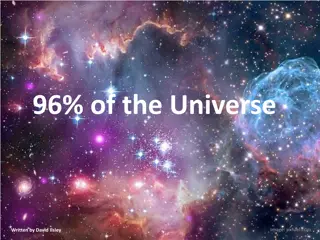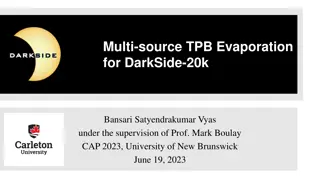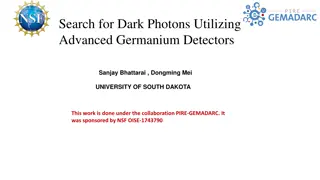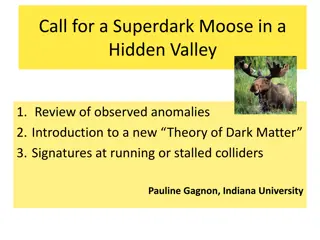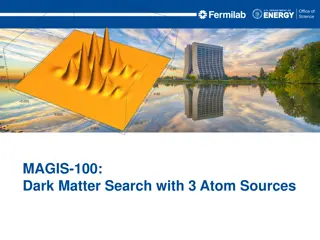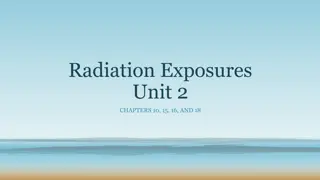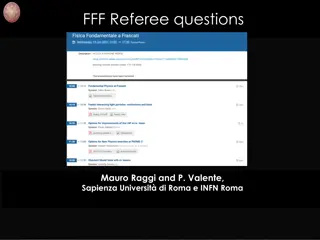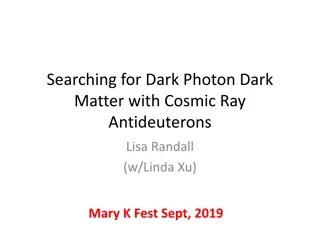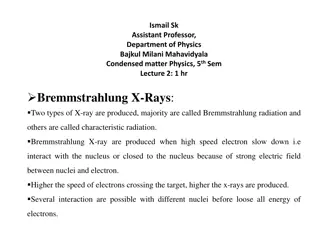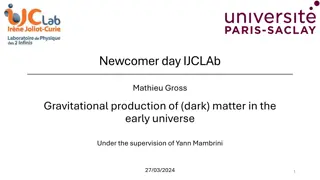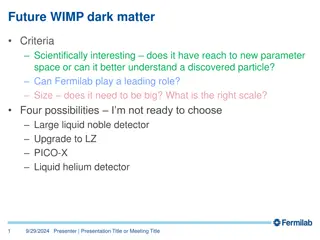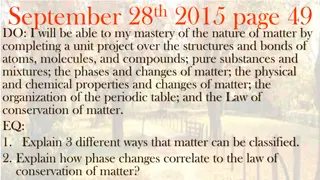Unveiling Dark Matter Mysteries Through Dark Photons
Delve into the exploration of dark matter through the lens of dark photons in the galactic center and detectors. Uncover the enigmatic nature of dark matter, its interactions, existing constraints, and our model with fermionic dark matter and a dark photon mediator. Discover strategies to evade constraints on dark matter interactions and the implications of DM-DM and DM-SM scattering. Witness the unfolding of dark matter mysteries through astrophysical observations and experimental insights.
Download Presentation

Please find below an Image/Link to download the presentation.
The content on the website is provided AS IS for your information and personal use only. It may not be sold, licensed, or shared on other websites without obtaining consent from the author. Download presentation by click this link. If you encounter any issues during the download, it is possible that the publisher has removed the file from their server.
E N D
Presentation Transcript
Dark Photons From the Galactic Center to Your Detector ANDREW GUSTAFSON IN COLLABORATION WITH VARUN MATHUR, IAN SHOEMAKER, AND MICHAEL GRAESSER (LANL) FOR CNP DAY 2023 1
Outline What is Dark Matter? Our model and interactions Existing constraints and how to avoid them Schematic Boosted Dark Photons from Dark Matter Annihilations Dark matter distribution and dark photon fluxes Boosted dark photon interactions Event Rates at Detectors 2
What is Dark Matter (DM)? Has been observed in: Galactic rotation curves Gravitational lensing of galactic mergers Structure formation Cosmological gravitational curvature Has not been observed in: Direct detection experiments Colliders Indirect Detection Searches Sizeable scattering in astrophysical scenarios [1] Corbelli, E.; Salucci, P. (2000). "The extended rotation curve and the dark matter halo of M33". Monthly Notices of the Royal Astronomical Society. 311 (2): 441 447. [2] Chandra X-Ray Observatory 3
Our Model Fermionic Dark Matter with a Dark Photon Mediator ? ????? ??? 1 +1 4? ????? 2? ??? ???? ? ???? 2?????? 2?? DM-DP Interactions Dark Matter (DM) Kinematics DP- Photon Kinetic Mixing Dark Photon (DP) Kinematics Time 4
Existing Constraints : DM-DM Scattering [3] Prateek Agrawal, Francis-Yan Cyr- Racine, Lisa Randall, and Jakub Scholtz, Make dark matter charged again, Journal of Cosmology and Astroparticle Physics 2017, 022 (2017). How to evade these bounds: Let ? make up ~10% of the total dark matter density. These gravitational observations can have sizable uncertainties. DM DM scattering constrained by Bullet Cluster observations and the ellipticity of galactic DM halos [3]. 5
Existing Constraints : DM-SM Scattering [4]Sensei Collaboration, Direct- detection results on sub-gev dark matter from a new skipper CCD , Phys. Rev. Lett. 125, 171802 (2020). [5]M. A. Buen-Abad, R. Essig, D. McKeen, and Y.-M. Zhong, Cosmological constraints on dark matter interactions with ordinary matter Physics Reports 961, 1 (2022). [6] A. Cruz and M. McQuinn, Astrophysical plasma instabilities induced by long-range interacting dark matter arXiv preprint arXiv:2202.12464 (2022). How to evade these bounds: Let ?? MeV. Below this mass, galactic dark matter lacks the energy necessary to produce visible signals in detectors. For CMB constraints, we need the cross- section to be small. DM SM interactions constrained by direct detection experiments (i.e. SENSEI [4]) and CMB observations [5]. For low-mass dark photons, constraints from DM-Galactic B-field interactions [6] . 6
Existing Constraints : DM Solar Cooling [7] S. Davidson, S. Hannestad, and G. Raffelt, JHEP 05, 003 (2000), arXiv:hep-ph/0001179. How to evade these bounds: Let ?? ?core? 10 keV , or pick ??? small so there is little coupling to EM currents. If ??< ?core in stars, then electromagnetic currents can produce ? which will escape and lead to over-cooling [7] 7
Existing Constraints : DP Mixing For DPs that mix with SM photons, this can lead to DPs free-streaming out of the Sun (and other stars). Stellar cooling observations and direct detection constrains these models. Constraints weaken when ?? < ?? (the plasma mass) [8] Andrea Caputo, Ciaran A. J. O Hare, Alexander J. Mil- lar, and Edoardo Vitagliano, Dark photon limits: a cook- book, (2021), arXiv:2105.04565 [hep-ph]. 8
DM w/ Boosted DP - Schematic Milky Way Halo Terrestrial Detector When ?? ?? the DPs from annihilation act as Long-Lived Particles with galactic scale decay lengths 1 4? 2 ?? < ?? > 2?? ? = 2 ? ?? ??? 9
? Distribution And DP Flux We let the ? distribution follow an NFW profile with a time-dependent scaling. ???,? = ? ? ?NFW(?) After picking a value of ??= ?(? = 0), we can then time-evolve the distribution due to annihilations. Given our choice of ?? and < ? ? >, we can then compute the flux of dark photons at Earth. 10
Dark Photon In-Medium Effects In matter, dielectric properties lead to a modified photon propagator via a polarization tensor . For transversely polarized photons in an isotropic, non- magnetic medium ?= ?2(1 ???? 1 ~??2 ?2 Photon Propagator Mixing On-shell condition ?2= ?? 2 2 ) ? ?? ?? 2 ?eff~ 2 11
Results Liquid Xenon/Argon Detectors Liquid Xenon Liquid Argon ??= 0.1 ;??= 1 keV 12
Results Gaseous Detectors Helium ? = 0.2 kg m 3 Xenon ? = 5 kg m 3 ??= 0.1 ;??= 1 keV 13
Results Gaseous Detectors Helium ? = 0.2 kg m 3, ?? = 0.3eV Xenon ? = 5 kg m 3, ?? = 1eV ??= 0.1 14
Conclusion Here, we explore the indirect detection of keV dark matter annihilating into dark photons with an optimized annihilation cross section. Future detectors can search for this signal if they have the following properties Large Volumes and Low Densities Gaseous detectors have less suppression from in-medium effects Low Energy Thresholds and Good Energy Resolution The signal will be a mono-energetic peak at the dark matter mass. Good Spatial Resolution Dark photons can interact anywhere within the detector, while most x-ray background will be on the detector edges 15
Thank You! 16
Bonus Slide Decaying Dark Matter An alternative model dark matter model could be a scalar ? which decays into DPs ? ? ? This could produce a flux of similar magnitude to the annihilating case. 17
Results Liquid Xenon/Argon Detectors Liquid Xenon Liquid Argon ??= 0.1 ;?? = 25 eV 18



